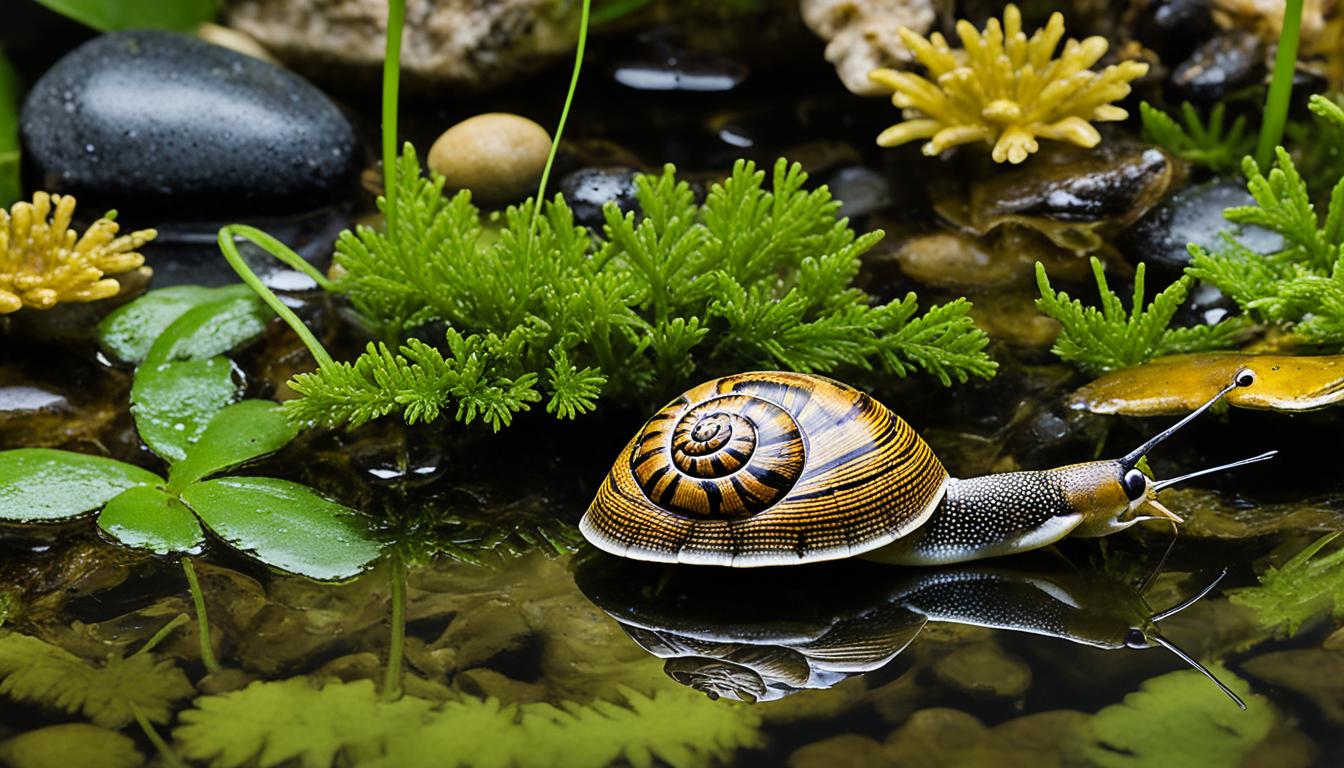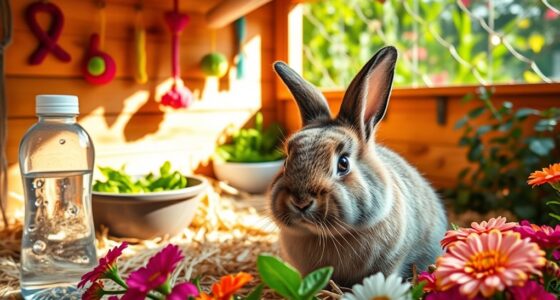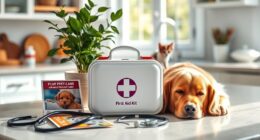To guarantee your cleaning routine is safe for pets, start by reviewing and replacing harmful chemicals with pet-safe, natural alternatives. Store all cleaning supplies securely out of reach, and check labels for toxic ingredients like ammonia or bleach. Maintain proper ventilation during and after cleaning to clear fumes, and establish a regular schedule to reduce dust and residues. Follow this checklist to create a healthier environment—there’s more to discover for a truly pet-friendly home.
Key Takeaways
- Use pet-safe, non-toxic cleaning products with natural ingredients and clear labels to prevent exposure to harmful chemicals.
- Store cleaning supplies securely out of pets’ reach and dispose of hazardous residues responsibly.
- Ensure proper ventilation during and after cleaning to reduce fumes and improve indoor air quality.
- Incorporate regular cleaning routines, including vacuuming, wiping surfaces, and washing pet bedding with safe products.
- Utilize air purifiers with HEPA filters and choose eco-friendly, natural cleaners to maintain a healthier environment for pets.
Assess Your Current Cleaning Products and Replace Harmful Chemicals

Before using any cleaning products around your pets, it is vital to review what you currently have in your home. Many household cleaners contain harmful chemicals that can jeopardize your pet’s health. Focus on identifying products used for pet stain removal and odor neutralization. Some ingredients, like ammonia or bleach, can irritate your pet’s skin or respiratory system. Replace these with pet-safe alternatives that effectively eliminate stains and odors without risking toxicity. Check labels carefully and opt for natural or non-toxic cleaners designed specifically for homes with pets. By evaluating and replacing harmful chemicals, you create a safer environment where your pets can roam freely without exposure to dangerous substances. Incorporating safe cleaning methods can further reduce potential risks and promote a healthier living space for everyone. This proactive step ensures a healthier, cleaner living space for everyone.
Choose Pet-Friendly Cleaning Alternatives
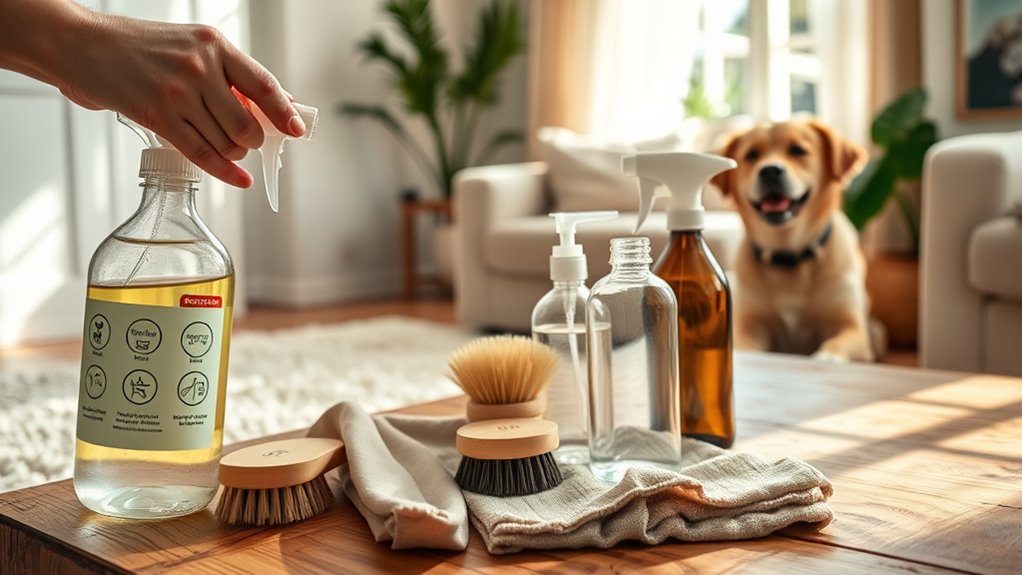
Choosing pet-friendly cleaning alternatives is essential for maintaining a safe environment for your furry friends. Instead of harsh chemicals, opt for pet stain removers that are specifically formulated to be safe around animals. Look for natural disinfectants like vinegar, baking soda, or plant-based solutions that effectively clean without toxic residues. These alternatives not only eliminate germs but also reduce the risk of allergic reactions or accidental poisoning. When shopping, read labels carefully to ensure the products are free from harmful chemicals. Using natural disinfectants and safe pet stain removers helps you keep your home clean and odor-free while protecting your pets’ health. Incorporating pinball machine safety tips can also be beneficial if you have a game room at home. Making these mindful choices creates a safer, healthier space for everyone in your household.
Read Labels Carefully to Identify Toxic Ingredients

Reading labels carefully is key to ensuring the cleaning products you choose are safe for your pets. To improve toxic ingredient awareness, use effective label reading strategies.
- Check the ingredient list for chemicals like phenols, ammonia, or bleach, which are toxic to pets.
- Look for labels that specify pet-safe or non-toxic formulations.
- Avoid products with vague terms like “fragrance” or “cleaning agents”—these can hide harmful substances.
- Research unfamiliar ingredients online to understand their safety profile.
Store Cleaning Supplies Safely Out of Reach of Pets
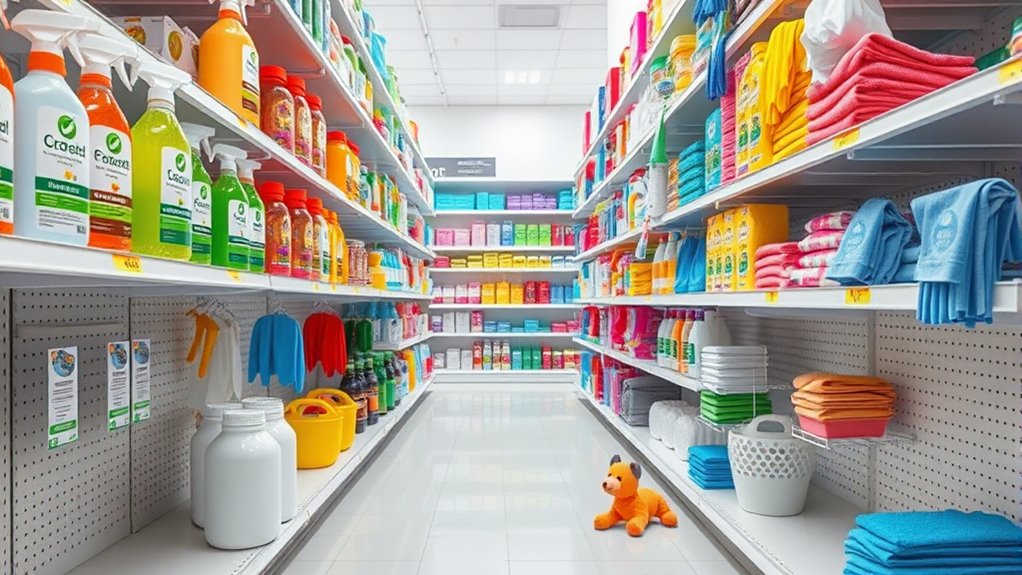
You should always keep cleaning supplies in secure storage options like cabinets with childproof locks or high shelves out of your pet’s reach. Proper disposal of empty bottles and leftover chemicals prevents accidental ingestion or exposure. Taking these steps helps protect your furry friends from potential hazards and keeps your home safe. Additionally, being aware of symptoms of poisoning can help you recognize and respond quickly if your pet is accidentally exposed to harmful substances.
Secure Storage Options
To keep your pets safe, it’s essential to store cleaning supplies out of their reach. Using proper storage options helps prevent accidental ingestion or contact. Consider these secure storage solutions:
- Use sturdy storage containers with tight-fitting lids for liquids and powders.
- Place cleaning supplies in lockable cabinets that pets cannot open.
- Keep sharp tools in high, inaccessible shelves.
- Store hazardous items behind closed doors, away from curious noses.
- Regularly check and maintain your storage areas to ensure all safety measures remain effective, especially considering the importance of pet-safe storage to prevent accidents.
Proper Disposal Methods
Proper disposal of cleaning supplies is crucial to prevent pets from accessing harmful substances after use. Always seal containers tightly and store them in a secure, out-of-reach location. Dispose of hazardous residue and biodegradable waste responsibly, following local regulations to avoid environmental harm. Never pour chemicals down the drain or into compost bins accessible to pets. Use designated disposal sites for hazardous waste, such as hazardous waste collection centers, to prevent accidental ingestion. Being aware of water safety practices can further help protect pets from accidental poisoning related to improper disposal.
Use Proper Ventilation During and After Cleaning
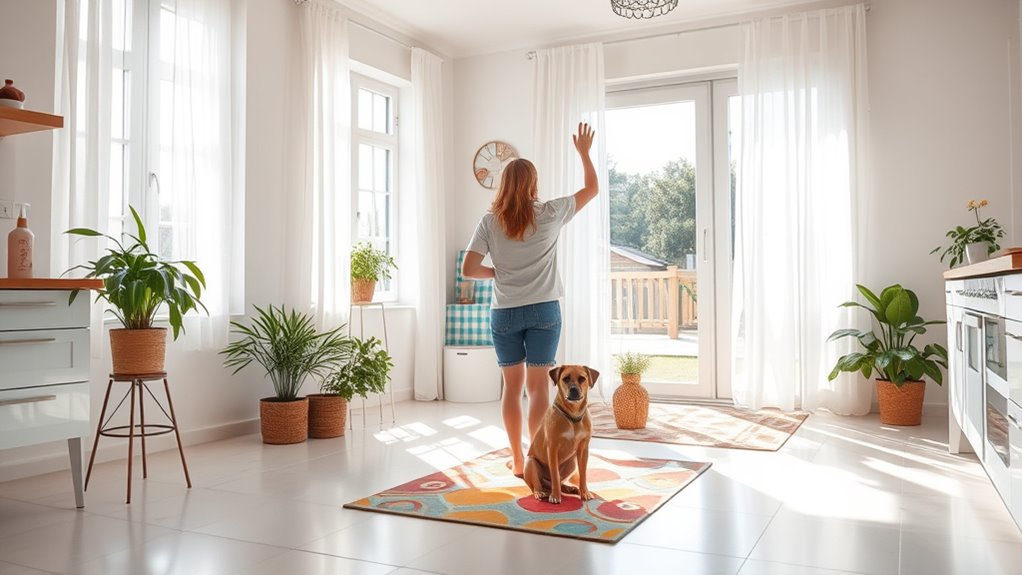
Ensuring good ventilation while cleaning is essential for keeping your pets safe. Proper air circulation helps remove airborne toxins and odors, creating a healthier environment. To maximize safety, consider these steps:
Good ventilation during cleaning protects pets from harmful fumes and odors.
- Open windows and doors to increase fresh air flow during cleaning.
- Use exhaust fans or air purifiers to improve odor removal and air quality.
- Keep pets out of the area until fumes dissipate completely.
- Allow continued ventilation after cleaning to ensure any lingering vapors are cleared.
Good ventilation reduces the risk of your pets inhaling harmful fumes or strong odors, which can cause irritation or health issues. Maintaining airflow during and after cleaning is a simple yet effective way to protect your furry friends.
Implement Regular Cleaning Routines to Reduce Toxins
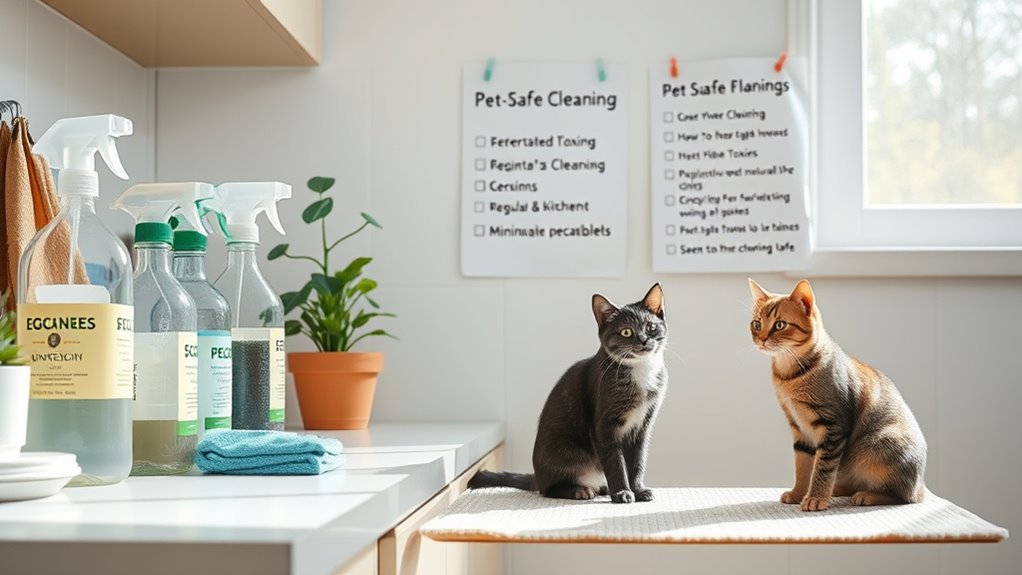
Maintaining a consistent cleaning schedule helps keep your home free of harmful toxins that can accumulate over time. Regular cleaning reduces pet toxins by removing dust, hair, and residues that can irritate your pet’s respiratory system. By establishing a steady cleaning frequency, you prevent the buildup of chemicals and allergens, creating a safer environment. Focus on high-traffic areas and spots where pet toxins tend to settle, like carpets, furniture, and pet bedding. Use pet-safe cleaning products whenever possible, and clean thoroughly but efficiently. Staying consistent with your routines ensures that harmful substances don’t linger, minimizing your pet’s exposure to toxins. Incorporating sound healing science principles into your cleaning routine, such as using specific frequencies or calming sounds, can promote a more relaxing and healthful atmosphere for both you and your pets. A reliable cleaning schedule is key to maintaining a healthy, toxin-free space where your pets can thrive safely.
Keep Pets Away During and Immediately After Cleaning
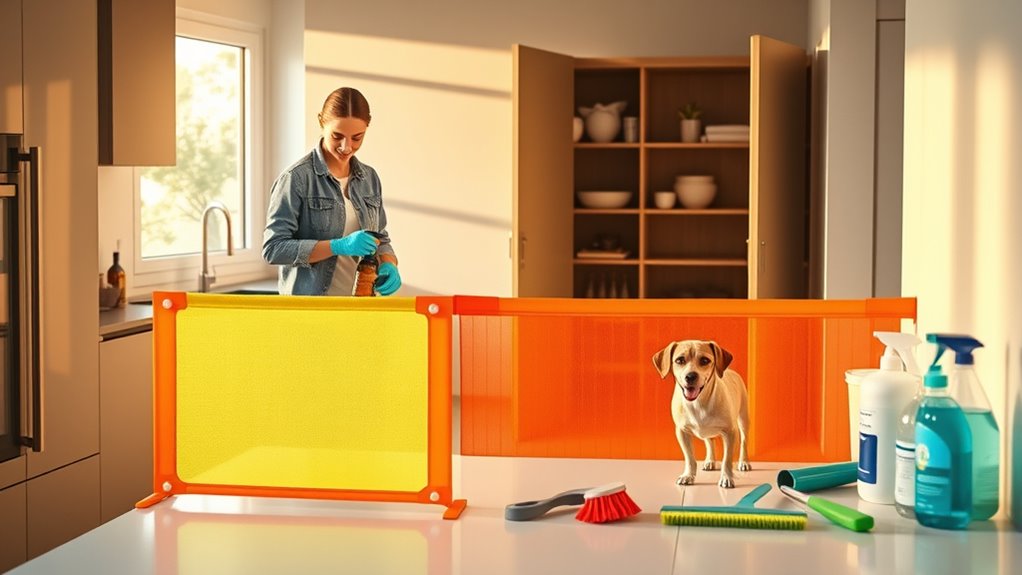
To protect your pets from exposure to cleaning chemicals, it’s important to keep them away during and immediately after cleaning sessions. This is crucial for a safe pet quarantine and to prevent accidental ingestion or contact with harmful substances. During cleaning time, follow these steps:
- Keep pets in a secure, designated pet quarantine area away from cleaning zones.
- Ventilate the space well before allowing pets back into the area.
- Wait at least 1-2 hours after cleaning before re-entering to ensure fumes dissipate.
- Never leave cleaning supplies or chemicals unattended where pets can access them.
Establish a Pet-Safe Cleaning Schedule and Checklist
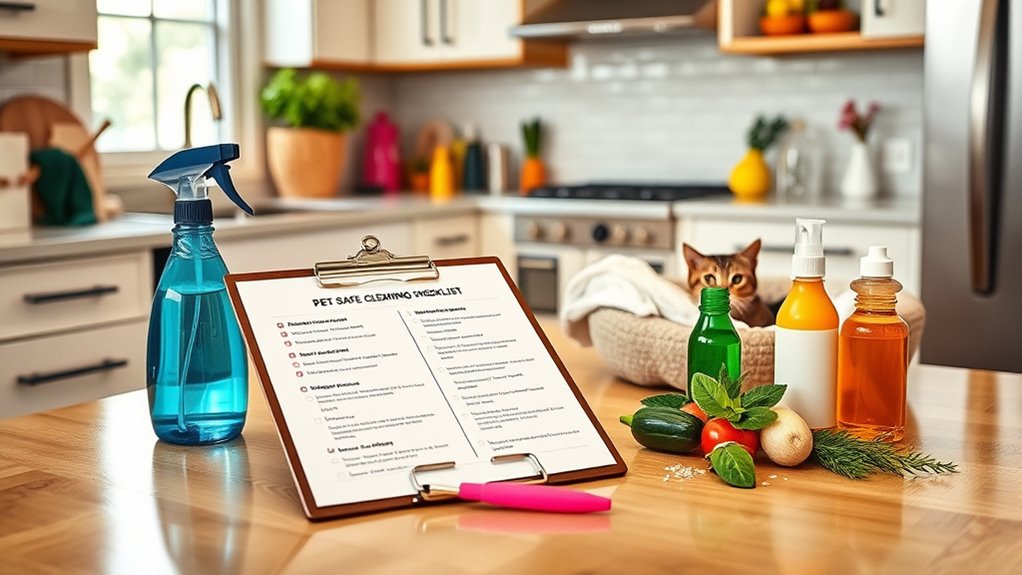
Setting up a cleaning schedule helps keep your home safe for your pets and maintains a tidy environment. Focus on daily routines that minimize exposure to harmful substances and dirt. Choose cleaning products carefully to guarantee they’re pet-friendly and won’t cause any health issues. Incorporating air purifier features and technology, such as HEPA filters, can further improve indoor air quality and reduce allergens and odors in your home.
Daily Cleaning Routine
Creating a daily cleaning routine that’s safe for your pet guarantees their environment stays healthy and free from harmful residues. Consistency helps maintain pet hygiene and controls odors effectively. To keep things on track, consider these steps:
- Wipe down surfaces daily with pet-safe disinfectants to prevent bacterial buildup.
- Sweep or vacuum floors regularly to remove pet hair, dirt, and allergens.
- Clean pet bedding and toys weekly to eliminate odors and bacteria.
- Spot clean any messes immediately to maintain cleanliness and prevent odor persistence.
- Using pet-safe cleaning products ensures that your cleaning routine remains safe for your furry friend while effectively maintaining hygiene.
Product Selection Guidelines
Choosing the right cleaning products is key to maintaining a safe environment for your pet. Look for products made with natural ingredients, which are less likely to cause allergic reactions or toxicity. Always read labels carefully—avoid harsh chemicals, artificial fragrances, and dyes. Opt for eco-friendly brands that prioritize sustainability and safety, ensuring their products are free from harmful substances. Consider using multi-purpose cleaners that are specifically formulated for pet-safe environments, reducing the risk of accidental exposure. When selecting products, prioritize those with transparent ingredient lists and certifications from reputable organizations. Additionally, selecting products with natural ingredients can further reduce potential risks to your pet’s health. By choosing safe, natural, and eco-friendly options, you help protect your pet’s health while keeping your home clean and fresh.
Frequently Asked Questions
Can Natural Cleaning Products Still Be Harmful to Pets?
Yes, natural cleaning products can still be harmful to your pets. Natural toxins found in some ingredients might cause allergic reactions or irritation, especially if ingested or inhaled. Additionally, chemical residues from natural cleaners can linger on surfaces, posing risks. Always read labels carefully, keep pets away during and after cleaning, and opt for products specifically labeled safe for pets to minimize these dangers.
How Can I Dispose of Cleaning Chemicals Safely Around Pets?
You should always handle chemical disposal carefully to keep your pets safe. After using cleaning chemicals, store them in pet-safe storage containers, out of your pets’ reach. When disposing of chemicals, follow your local waste disposal guidelines to prevent contamination. Never pour chemicals down the drain or onto the ground where pets might come into contact. Proper chemical disposal and pet-safe storage protect your furry friends from accidental poisoning.
Are Essential Oils Safe to Use Around Pets During Cleaning?
Essential oils are generally not safe to use around pets during cleaning, as many can cause toxicity or allergic reactions. Pet safety should always come first; avoid diffusing or applying oils directly in areas your pets frequent. If you want to use essential oils, opt for pet-safe varieties and consult your veterinarian beforehand. Always verify good ventilation and store oils out of your pet’s reach to prevent accidental ingestion or exposure.
What Are Signs of Poisoning From Cleaning Products in Pets?
If your pet shows signs of poisoning from cleaning products, you’ll notice symptoms like vomiting, diarrhea, drooling, difficulty breathing, or lethargy. These are common toxic reactions, and you should act quickly. Don’t wait—remove your pet from the contaminated area, keep them calm, and seek emergency veterinary care immediately. Recognizing poisoning symptoms early can save your pet’s life and make certain prompt treatment.
How Often Should I Replace Cleaning Tools to Ensure Safety?
Imagine your cleaning tools as loyal companions who need fresh energy to perform their best. You should replace them every few months, depending on usage and wear. Regular cleaning frequency and tool maintenance guarantee they stay effective and safe for your pets. Keep an eye out for frayed bristles or lingering odors, and swap them out promptly. This way, your cleaning routine remains safe, efficient, and pet-friendly.
Conclusion
Think of your home as a safe harbor for your pets. By following this checklist, you’re steering clear of hidden dangers lurking in everyday cleaning. Each step is like adjusting your sails to keep your furry friends protected and happy. With mindful choices and consistent routines, you create a clean, welcoming environment where your pets can thrive. Remember, a safe home isn’t just built—it’s maintained with love and care every day.



